Measuring business performance is the key to company growth.
For any business, it’s important to understand the current state of progress to learn what is working and what’s not. However, with so many performance metrics to track it can be a challenge to understand which ones suit your business best and help drive the sought after changes.
What’s even more challenging is to understand how exactly to drive these metrics and who should be responsible for them? Setting KPIs (Key Performance Indicators) is just as important as setting OKRs (Objectives and Key Results) to measure the right things and move the needle.
In this article, we’re comparing OKR vs KPI, two frameworks commonly used in business, we’ll share:
- What do OKR and KPI stand for?
- OKR vs KPI examples
- What’s the difference between OKR and KPI?
- Can OKRs and KPIs work together?
Differences Between OKRs and KPIs
Both OKRs and KPIs are measurable and reflect the team’s performance. When comparing OKRs vs KPIs, the main difference is:
- What exactly you measure;
- How you come up with those measurements.
KPIs are high-level business performance metrics that you analyze with precise frequency (yearly, quarterly, monthly, weekly, etc.). KPIs are used to measure performance but they don’t tell you what needs to change or improve to drive the growth of those numbers.
OKR is a quarterly goal-setting method that helps businesses improve performance and drive change. OKRs are used to decide what needs to be changed, fixed, or improved.
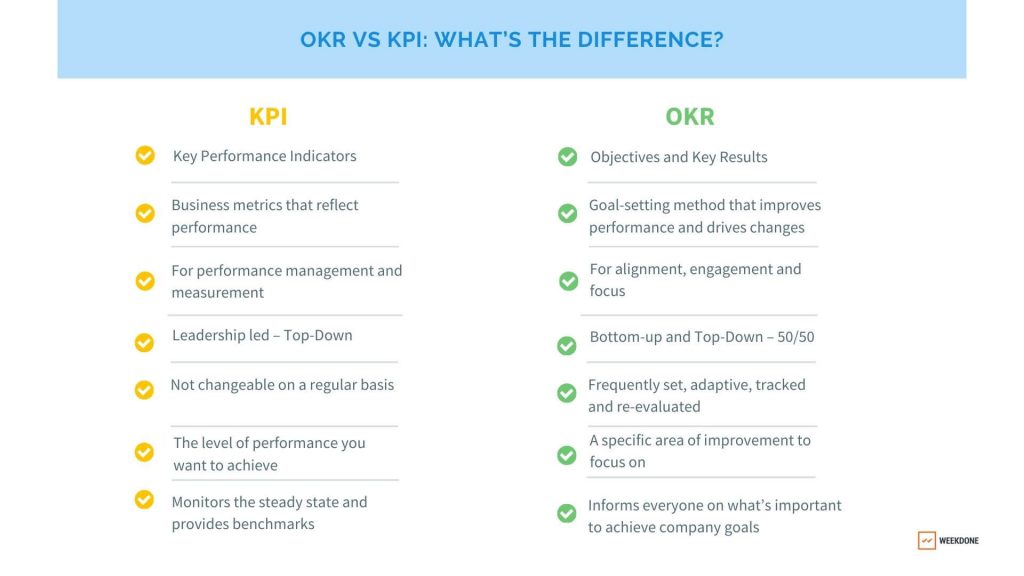
Company trial for unlimited users.
What is a KPI?
KPI is an acronym for Key Performance Indicator. The KPI in business is often set in order to provide numerical targets for achieving specific goals.
These measurable numbers demonstrate how effectively your business is moving towards goals – such as, targeted quarterly revenue or targeted new customers per month. KPIs help companies, departments, teams, and individuals set clear targets and monitor their progress on those values.
In most companies, KPIs reflect revenue targets and month by month growth of various business metrics. You can track all of your regular business activities with KPIs, i.e.
- revenue is $100,000 MRR
- customer acquisition cost is $100
- monthly website traffic is 10,000 new visitors
- average transaction value is $1,000
- deals closed by a sales person per month is 10
- sales by the region is 100, etc.
These targets can be annual, quarterly, monthly, daily, or even hourly, depending on what you wish to keep an eye on.
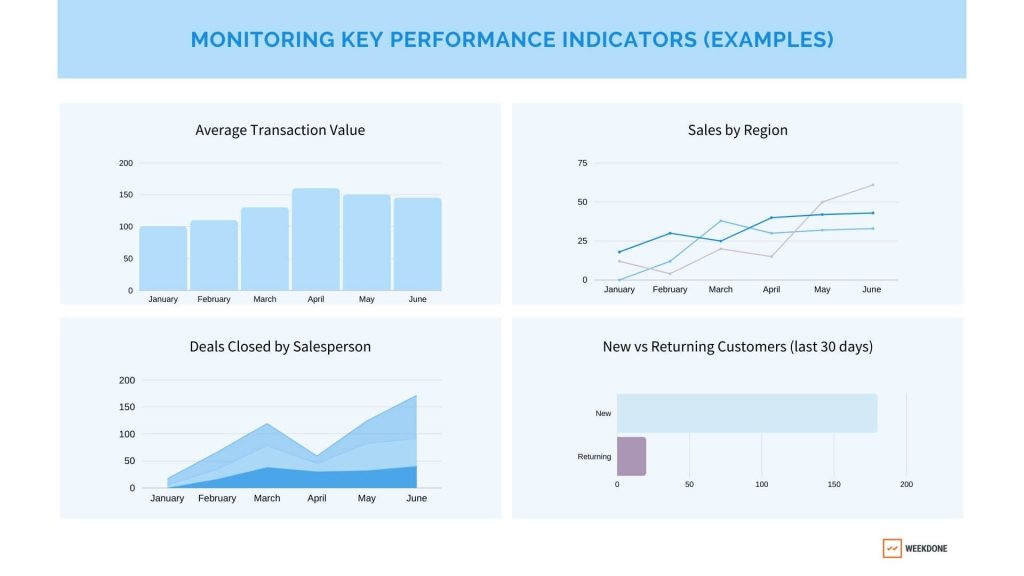
The purpose of KPI is to analyze past performance and make predictions for the future. For example, which months or regions are going to bring in sales, how many deals will be closed by a salesperson, or what average transaction value to expect.
KPI Examples
Here are some common KPI examples for different teams. KPIs are usually achieved through business-as-usual tasks and as a part of the daily routine.
Notice how quantitative, measurable and target-oriented they are:
Sales KPIs
- 1,000 new inbound leads per month
- Lead response time is 2 days
- Lead conversion rate is 3%
- Average order value is $1,000
- Average sales cycle time is 2 months
- Upsell is 50%
Marketing KPIs
- 1,000 Marketing Qualified Leads (MQLs)
- 100 Sales Qualified Leads (SQLs)
- Cost per Lead is $100
- 10% conversion rate from a website visitor to lead
- 100,000 monthly new visitors from organic traffic
- Customer Lifetime Value (CLV) is $1,000
Customer Success KPIs
- Customer Churn Rate is 5%
- Average Revenue Per User (ARPU) is $1,500
- Customer Retention Cost (CRC) is $100
- First Response Time (FRT) over chat is 3 minutes
- Customer Satisfaction Score (CSAT) is 80%
- Net Promoter Score (NPS) is 70
Product Management KPIs
- On-Time Delivery (each release) is 20 days
- The number of Daily Active Users (DAU) is 1,000
- Retention rate is 20%
- Session duration is 10 minutes
- Number of user actions per session is 10
- Bounce rate is 30%
What is an OKR?
OKR stands for: Objectives and Key Results. OKRs in business are used to communicate desired outcomes throughout the organization, bring focus to key improvement areas, and deliver valuable results for the business.
In most cases, OKRs reflect areas of improvement (aka your Objectives) which can help achieve KPI targets. That improvement area is measured by Key Results which help track the impact of those changes your team or company decided to make. You can improve any area of your business with OKRs i.e.:
- increase engagement with your product or service,
- personalize sales approach and nurture new potential customers better,
- leverage “social proof” to increase credibility and improve reputation,
- increase the number of high quality leads,
- scale QA Engineering team,
- build a financial planning engine that improves accounting processes and accelerates business growth.
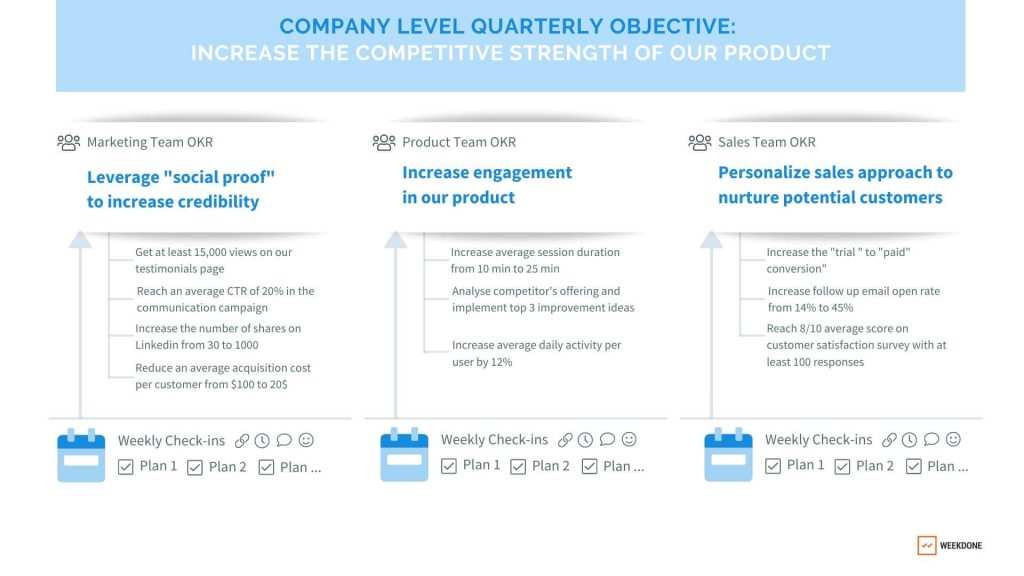
The purpose of the OKR methodology is to single out improvement areas for the quarter and focus your teams’ attention on delivering valuable business results.
OKR Examples with Initiatives
OKRs are the bridge between where you are and where you want to be. Notice how these team OKR examples are not only measurable, but also inspirational and action-driven.
Here are general OKR examples with Initiatives so you can see how each team would take actionable steps toward achieving them during a quarter.
Product Team OKRs
Objective
Increase engagement in our product
Key results
- KR1: Increase average session duration from 10 min to 25 min
- KR2: Analyze competitor’s offering and implement top 3 improvement ideas
- KR3: Increase average daily activity per user by 12%
Initiatives
- Make a list to compare our product with the competitor and brainstorm ideas for improvement
- Reach out to loyal customers and ask for feedback
- Design and launch a “wow” feature to ignite discussions and trigger customer engagement
Marketing Team OKRs
Objective
Leverage “social proof” to increase credibility and improve reputation
Key Results
- KR1: Get at least 15,000 views on our testimonials page
- KR2: Reach an average click-through rate of 20% in the communication campaign
- KR3: Increase the number of shares on Linkedin from 30 to 1,000
- KR4: Reduce an average acquisition cost per customer from $100 to 20$
Initiatives
- Partner up with thought leaders to promote our testimonials page
- Reach out to power users and ask to share their success stories in video format
- Brainstorm ideas for LinkedIn marketing
Sales Team OKRs
Objective
Personalize sales approach and nurture new potential customers better
Key Results:
- KR1: Increase the number of touch points with a new lead from 3 to 6
- KR2: Increase follow up email open rate from 14% to 45%
- KR3: Reach 8/10 average score on customer satisfaction survey with at least 100 responses
Initiatives
- Update the customer journey map to improve the nurturing process
- Take a course on best practice email approaches and consult with the Marketing team
- Create different offers for different use cases, review the sales pitch
Customer Success Team OKRs
Objective:
Increase engagement with new paying customers
Key Results:
- KR1: Increase open rate of our in-product communication from 4% to 15%
- KR2: Increase the number of follow-up meetings booked from 7 to 21 per week
- KR3: Achieve service quality rating 9 out of 10 based on the after meeting anonymous poll
- KR4: Reduce average response time from 5h to 1h
Initiatives
- Analyze open rate from previous quarter and draft new copies for in-app messages
- Personalize outgoing communication
- Create a high quality FAQ section and stock answers to speed up responses
- Survey our high engagement customers to ask what they like in our services
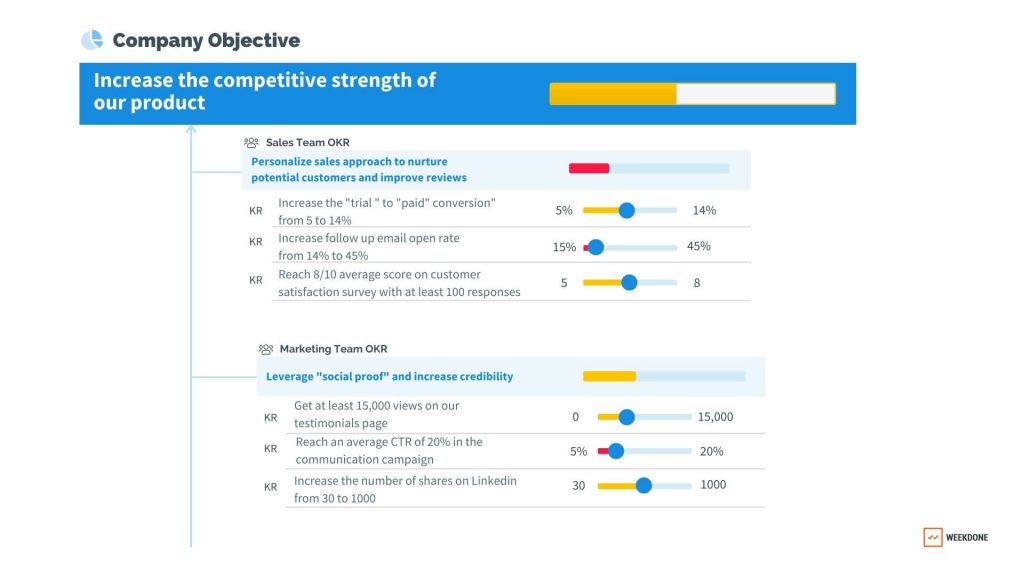
Which is Better – OKR vs KPI
Rather than asking which is better, we should consider how the two compliment each other. KPI being a conversation starting point about where to improve, changes to implement, or problems to solve. Further, OKR specifies an area of focus with measurable outcomes to strive for in order to deliver those improvements.
Analyzing business performance against KPI targets gives executives an understanding of where business stands and how to keep it going. Without KPIs, a company can quickly lose direction and purpose. Simply put, its difficult to lead a functional, well-organized company if you are not measuring KPIs.
However, these numbers don’t really tell you directly how to meet or improve them. You cannot grow a business by simply saying “we need to hit a higher revenue target”.
If you’re falling behind on KPI targets, what exactly do you need to improve to put everything back on track? Thats where OKRs come in. OKRs give teams and employees stake in the game, so to speak.
Review the KPI and OKR progress dashboard below in Weekdone. The color-coded system makes it easy to see at a glance where things are on track, at risk, or off track for the given quarter.
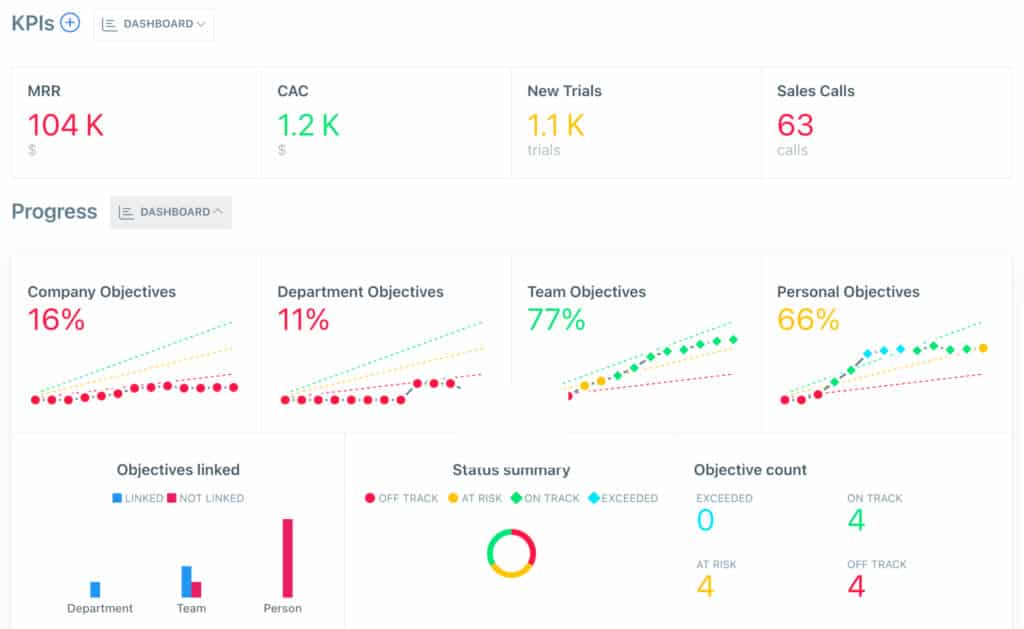
Track OKRs and KPIs at once
Add KPIs and OKRs into Weekdone to manage, track, and assess business performance, improvement and progress.
Combining OKRs and KPIs – Team Example
There are two specific cases when a KPI value suggests that an OKR is needed to address a particular issue:
- If you’re falling behind on your KPI target, you need an OKR to put everything back on track.
- If you want to achieve a more ambitious KPI target (like a big revenue number), you need OKRs that will guide you there.
Example: Company A’s Customer Success team has a KPI target of 100 meetings per quarter. They realize that to onboard more customers and increase customer lifetime value, they need to have more meetings. So they decide to pursue a much higher KPI target of 300 meetings per quarter.
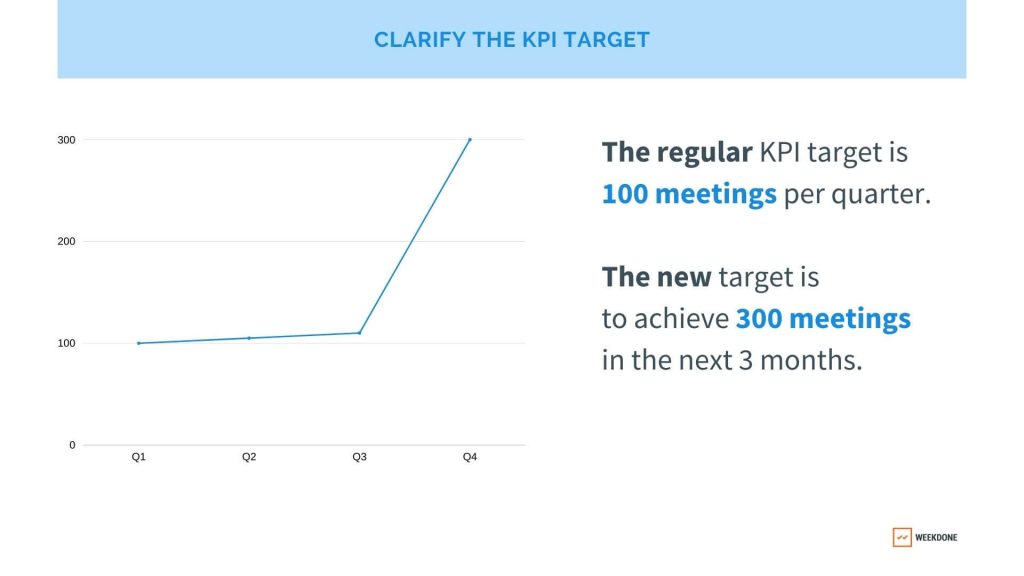
1. Have a discussion
Once the KPI target is clarified, it’s a good starting point to move on to discussing what could be improved by setting OKRs. So, what exactly does the Customer Success team need to focus on to deliver on the target of 300 meetings in 3 months?
To find and prioritize the most impactful improvement area, company A’s Customer Success team would set up a discussion. Some questions to guide this discussion could be:
- Will we focus on new customers or the ones who subscribed in the past 6 months?
- How will the team approach this: through email communication, in-product notifications or a landing page?
- Would it be more impactful to focus on long-term customers and engage them more often?
- How many meetings per customer is enough to make sure continuous usage and engagement?
- If customers are not booking follow ups, is it because of the bad first impression? Should the team consider improving the sales pitch and demo approach?
Team discussions are the key to team alignment through which it would become clear that some areas are more impactful than others, and you have more faith and confidence in some ideas for delivering actual change. The outcomes of the discussion would serve as a basis for the right objective setting.
👉 Choose a Customer Success OKR template to use as a baseline for your own Objectives and Key Results.
2. Writing the OKR + create your execution plan
To continue with our example, let’s imagine that the Customer Success team decided to focus on the customers who subscribed in the past 3 months and increase engagement with them. The team will apply different tactics to deliver on the desirable outcomes. But which outcomes are desirable here?
Usually, companies think that the KPI should be one of the Key Results under the Objective, but this isn’t a best practice.
Bad Objective: Increase the number of meetings from 100 to 300
This is just reiterating the KPI target. Instead, try to identify an outcome that the team can influence on an ongoing basis.
Good Objective: Improve customer loyalty and satisfaction
The team can track this each week and take action when progress is at risk. This is an improvement area that this team can directly impact
Remember, you should have at least 3-5 Key Results per Objective. For OKRs to work, you need to define the Objective so clearly that it would shape the thought process and prioritization framework for the entire quarter.
Knowing the actual outcomes helps the team to choose the right tasks to work on, Initiatives/projects to plan as to not waste their time pursuing everything that comes to mind. OKRs keep everyone focused.
3. Analyze progress and further improvements
This KPI growth might not be immediate, but success is not a single leap from zero to hero. It’s a process of fixing weaknesses and strengthening your best features. So if the OKR you set this quarter didn’t impact business the way you anticipated, you can analyze what worked and what didn’t, and come up with a better approach, and a better team OKR for the next quarter.
By analyzing your OKR progress in retrospect (in Team Weekly OKR check-ins, or monthly reviews), you are figuring out and documenting exactly how you are most likely to improve your business and achieve your ambitious KPI targets.
Company trial for unlimited users.
FAQ
KPIs and OKRs coexist very well and you should use both frameworks in your business, each serving a different purpose. Use OKRs for goal-setting and improving your current state of business and KPIs for monitoring general business performance.
KPIs show what should be analyzed to help determine the basis for OKRs. Once you’ve decided on which area (KPI) needs improvement, you write an Objective focused on that + Key Results to measure how close you’re getting to achieve that Objective in order to move the needle on a KPI.
OKRs are not business performance metrics, KPIs are. The purpose of OKRs is to decide what exactly you need to improve in your business and based on that, how you will spend your time and resources in the next 3 months.
OKRs give focus on the short term, therefore it is as much about saying “no” to opportunities, as it is about pursuing them.
A growing KPI refers to one which has a “start value” and “target value”. Growing KPIs are best for metrics you want to grow, for example: new clients, subscribers, views, page traffic, and more.
Read more about growing KPIs here.
The horizontal KPI shows a minimum and maximum value – best for KPIs where you want to stay within a certain range. For example: bug reports, churn rate, and more.
Read more about horizontal KPIs here.